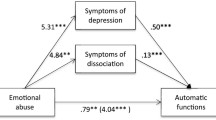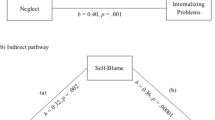Abstract
The purpose of this study was to examine the relationship between childhood abuse, assault, cognitive distortion, and non-suicidal self-injury (NSSI) in a clinical adolescent sample. The sample included one hundred eighty-five psychiatrically hospitalized adolescents and their parents. Adolescent participants were predominantly female (71.4%), Caucasian (84%), and of non-Hispanic ethnicity (9.2%). Participants completed a diagnostic interview and self-report measures to assess youth history of abuse and assault, cognitive errors, negative self-views, and recent NSSI. No relationship was found between childhood abuse and NSSI. However, a history of assault was associated with NSSI among youth who reported higher cognitive errors and more negative self-views, even after controlling for gender and internalizing disorders. These results suggest that existing affect regulation models of NSSI may be enhanced by incorporating the role of cognitive distortion. Clinically, results also suggest that assessing adolescent victims of assault for cognitive errors and negative self-views, and helping them restructure these cognitive distortions when present, may reduce the likelihood of NSSI.


Similar content being viewed by others
References
Adams, G., & Marshall, S. (1996). A developmental social psychology of identity: Understanding the person-in-context. Journal of Adolescence, 19, 429–442.
Agresti, A. (2002). Categorical data analysis. Hoboken, NJ: Wiley.
Beck, A. T. (1967). Depression: Clinical, experimental, and theoretical aspects. New York, NY: Harper & Row.
Beck, A. T., Emery, G., & Greenberg, R. (1985). Anxiety disorders and phobias: A cognitive perspective. New York, NY: Basic Books.
Brown, L., Houck, C., Grossman, C., Lescano, C., & Frenkel, J. (2008). Frequency of adolescent self-cutting as a predictor of HIV risk. Journal of Developmental and Behavioral Pediatrics, 29, 161–165.
Cantwell, D. P., Lewinsohn, P. M., Rohde, P., & Seeley, J. R. (1997). Correspondence between adolescent report and parent report of psychiatric diagnostic data. Journal of the American Academy of Child and Adolescent Psychiatry, 36, 610–619.
Chapman, A., Gratz, K., & Brown, M. (2006). Solving the puzzle of deliberate self-harm: The experiential avoidance model. Behaviour Research and Therapy, 44, 371–394.
Costello, D., Swendsen, J., Rose, J., & Dierker, L. (2008). Risk and protective factors associated with trajectories of depressed mood from adolescence to early adulthood. Journal of Consulting and Clinical Psychology, 76, 173–183.
DiClemente, R., Ponton, L., & Hartley, D. (1991). Prevalence and correlates of cutting behavior: Risk for HIV transmission. Journal of the American Academy of Child and Adolescent Psychiatry, 30, 735–739.
DuMont, K., Widom, C., & Czaja, S. (2007). Predictors of resilience in abused and neglected children grown-up: The role of individual and neighborhood characteristics. Child Abuse & Neglect, 31(3), 255–274.
Glassman, L., Weierich, M., Hooley, J., Deliberto, T., & Nock, M. (2007). Child maltreatment, non-suicidal self-injury, and the mediating role of self-criticism. Behaviour Research and Therapy, 45, 2483–2490.
Gratz, K., Conrad, S., & Roemer, L. (2002). Risk factors for deliberate self-harm among college students. American Journal of Orthopsychiatry, 72, 128–140.
Hilt, L. M., Cha, C. B., & Nolen-Hoeksema, S. (2008). Nonsuicidal self-injury in young adolescent girls: Moderators of the distress-function relationship. Journal of Consulting and Clinical Psychology, 76, 63–71.
Jacobs, R. H., Reinecke, M. A., Gollab, J. K., & Kane, P. (2008). Empirical evidence of cognitive vulnerability for depression among children and adolescents: A cognitive science and developmental perspective. Clinical Psychology Review, 28, 759–783.
Kaslow, N., Stark, K., Printz, B., & Livingston, R. (1992). Cognitive triad inventory for children: Development and relation to depression and anxiety. Journal of Clinical Child Psychology, 21, 339–347.
Kaufman, J., Birmaher, B., Brent, D. A., Rao, U., & Ryan, N. D. (1997). Schedule for affective disorders and schizophrenia for school age children, present and lifetime version (K-SADS-PL): Initial reliability and validity data. Journal of the American Academy of Child and Adolescent Psychiatry, 36, 980–988.
Kaufman, A. S., & Kaufman, N. L. (1990). Kaufman brief intelligence test: Manual. Circle Pines, MN: American Guidance Service.
Kendall, P. C., & Dobson, K. S. (1993). On the nature of cognition and its role in psychopathology. In K. S. Dobson & P. C. Kendall (Eds.), Psychopathology and cognition (pp. 3–19). New York: Academic Press.
Klein, D. N., Lewinsohn, P. M., Seeley, J. R., & Rohde, P. (2001). A family study of major depressive disorder in a community sample of adolescents. Archives of General Psychiatry, 58, 13–20.
Klein, D. N., Ouimette, P. C., Kelly, H. S., Ferro, T., & Riso, L. P. (1994). Test–retest reliability team consensus best-estimate diagnoses of Axis I and II disorders in a family study. American Journal of Psychiatry, 151, 1043–1047.
Klonsky, E. D., & Moyer, A. (2008). Childhood sexual abuse and non-suicidal self-injury: Meta-analysis. British Journal of Psychiatry, 192, 166–170.
Krupnick, J., Green, B., Stockton, P., Goodman, L., Corcoran, C., & Petty, R. (2004). Mental health effects of adolescent trauma exposure in a female college sample: Exploring differential outcomes based on experiences of unique trauma types and dimensions. Psychiatry: Interpersonal and Biological Processes, 67, 264–279.
Lawyer, S., Ruggiero, K., Resnick, H., Kilpatrick, D., & Saunders, B. (2006). Mental health correlates of the victim-perpetrator relationship among interpersonally victimized adolescents. Journal of Interpersonal Violence, 21, 1333–1353.
Leitenberg, H., Yost, L., & Carroll-Wilson, M. (1986). Negative cognitive errors in children: Questionnaire development, normative data, and comparisons between children with and without self-reported symptoms of depression, low self-esteem, and evaluation anxiety. Journal of Consulting and Clinical Psychology, 54, 528–536.
Lloyd-Richardson, E., Perrine, N., Dierker, L., & Kelley, M. (2007). Characteristic and functions on non-suicidal self-injury in a community sample of adolescents. Psychological Medicine, 37, 1183–1192.
Messer, J., & Fremouw, W. (2008). A critical review of explanatory models for self-mutilating behaviors in adolescents. Clinical Psychology Review, 28, 162–178.
Najmi, S., Wegner, D., & Nock, M. (2007). Thought suppression and self-injurious thoughts and behaviors. Behaviour Research and Therapy, 45, 1957–1965.
Nock, M. K., Joiner, T. E., Gordon, K. H., Lloyd-Richardson, E., & Prinstein, M. J. (2006). Non-suicidal self-injury among adolescents: Diagnostic correlates and relation to suicide attempts. Psychiatry Research, 144, 65–72.
Nock, M., & Prinstein, M. (2004). A functional approach to the assessment of self-mutilative behavior. Journal of Consulting and Clinical Psychology, 72, 885–890.
Nock, M., & Prinstein, M. (2005). Contextual features and behavioral functions of self-mutilation among adolescents. Journal of Abnormal Psychology, 114, 140–146.
Noll, J., Horowitz, L., Bonanno, G., Trickett, P., & Putnam, F. (2003). Revictimization and self-harm in females who experienced childhood sexual abuse: Results from a prospective study. Journal of Interpersonal Violence, 18, 1452–1471.
Penn, J., Esposito, C., Schaeffer, L., Fritz, G., & Spirito, A. (2003). Suicide attempts and self-mutilative behavior in a juvenile correctional facility. Journal of the American Academy of Child and Adolescent Psychiatry, 42, 762–769.
Prezant, D., & Neimeyer, R. (1988). Cognitive predictors of depression and suicide ideation. Suicide and Life-Threatening Behavior, 18, 259–264.
Ross, S., & Heath, N. (2002). A study of the frequency of self-mutilation in a community sample of adolescents. Journal of Youth and Adolescence, 31, 67–77.
Timbremont, B., & Braet, C. (2006). Brief report: A longitudinal investigation of the relation between a negative cognitive triad and depressive symptoms in youth. Journal of Adolescence, 29, 453–458.
Tjaden, P., & Thoennes, N. (2000). Prevalence and consequences of male to female and females to male intimate partner violence as measured by the National Violence Against Women Survey. Violence Against Women, 6, 142–161.
Waldrop, A., Hanson, R., Resnick, H., Kilpatrick, D., Naugle, A., & Saunders, B. (2007). Risk factors for suicidal behavior among a national sample of adolescents: Implications for prevention. Journal of Traumatic Stress, 20, 869–879.
Weems, C. F., Berman, S. L., Silverman, W. K., & Saaverdra, L. M. (2001). Cognitive errors in youth with anxiety disorders: The linkages between negative cognitive errors and anxious symptoms. Cognitive Therapy and Research, 25, 559–575.
Whisman, M. A. (2006). Childhood trauma and marital outcomes in adulthood. Personal Relationships, 13, 375–386.
Zoroglu, S., Tuzun, U., Sar, V., Tutkun, H., Savas, H., Ozturk, M., et al. (2003). Suicide attempt and self-mutilation among Turkish high school students in relation with abuse, neglect and dissociation. Psychiatry and Clinical Neurosciences, 57, 119–126.
Acknowledgments
This research was supported by a grant from the National Institute of Mental Health (NIMH) R01MH065885 awarded to the second author (CES).
Author information
Authors and Affiliations
Corresponding author
Rights and permissions
About this article
Cite this article
Weismoore, J.T., Esposito-Smythers, C. The Role of Cognitive Distortion in the Relationship Between Abuse, Assault, and Non-Suicidal Self-Injury. J Youth Adolescence 39, 281–290 (2010). https://doi.org/10.1007/s10964-009-9452-6
Received:
Accepted:
Published:
Issue Date:
DOI: https://doi.org/10.1007/s10964-009-9452-6




